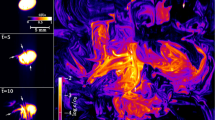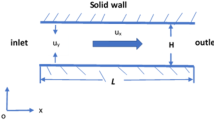Abstract
This article presents a three-dimensional analytical model to investigate cross-stream diffusion transport in rectangular microchannels with arbitrary aspect ratios under pressure-driven flow. The Fourier series solution to the three-dimensional convection–diffusion equation is obtained using a double integral transformation method and associated eigensystem calculation. A phase diagram derived from the dimensional analysis is presented to thoroughly interrogate the characteristics in various transport regimes and examine the validity of the model. The analytical model is verified against both experimental and numerical models in terms of the concentration profile, diffusion scaling law, and mixing efficiency with excellent agreement (with <0.5% relative error). Quantitative comparison against other prior analytical models in extensive parameter space is also performed, which demonstrates that the present model accommodates much broader transport regimes with significantly enhanced applicability.











Similar content being viewed by others
Notes
In Lam’s paper (2005), the expression form of \( \lambda_{1,2} \) is incorrect.
It should be pointed out the analytical solution in Lam et al. (2005) is erroneous, which overestimates the contribution from the Taylor dispersion by more than 3%. By rectifying their solution, the Taylor dispersion is marginal (much less than 1%) in the species transport, which agrees with our dimensional analysis herein.
References
Akpa BS et al (2007) Study of miscible and immiscible flows in a microchannel using magnetic resonance imaging. Anal Chem 79(16):6128–6134
Aurouz PA et al (2002) Micro total analysis systems. 2. Analytical standard operations and applications. Anal Chem 74:2637–2652
Ayodele SG, Varnik F, Raabe D (2009) Effect of aspect ratio on transverse diffusive broadening: a lattice Boltzmann study. Phys Rev E 80(1):016304
Beard DA (2001a) Taylor dispersion of a solute in a microfluidic channel. J Appl Phys 89(8):4667–4669
Beard DA (2001b) Response to “Comment on ‘Taylor dispersion of a solute in a microfluidic channel’ [J. Appl. Phys. 90, 6553 (2001)]”. J Appl Phys 90(12):6555–6556
Bissacco A, Yang MH, Soatto S (2007) Fast human pose estimation using appearance and motion via multi-dimensional boosting regression. In: IEEE computer society conference on computer vision and pattern recognition
Chen JM, Horng TL, Tan WY (2006) Analysis and measurements of mixing in pressure-driven microchannel flow. Microfluid Nanofluid 2(6):455–469
de Almeida GL, Pimentel LCG, Cotta RM (2008) Integral transform solutions for atmospheric pollutant dispersion. Environ Model Assess 13(1):53–65
Dertinger SKW et al (2001) Generation of gradients having complex shapes using microfluidic networks. Anal Chem 73(6):1240–1246
Dorfman KD, Brenner H (2001) Comment on “Taylor dispersion of a solute in a microfluidic channel” [J. Appl. Phys. 89, 4667 (2001)]. J Appl Phys 90(12):6553–6554
Erickson D, Li DQ (2002) Influence of surface heterogeneity on electrokinetically driven microfluidic mixing. Langmuir 18(5):1883–1892
Hatch A, Garcia E, Yager P (2004) Diffusion-based analysis of molecular interactions in microfluidic devices. Proc IEEE 92(1):126–139
Holden MA et al (2003) Generating fixed concentration arrays in a microfluidic device. Sens Actuators B 92(1–2):199–207
Ismagilov RF et al (2000) Experimental and theoretical scaling laws for transverse diffusive broadening in two-phase laminar flows in microchannels. Appl Phys Lett 76(17):2376–2378
Jeon NL et al (2000) Generation of solution and surface gradients using microfluidic systems. Langmuir 16(22):8311–8316
Kamholz AE, Yager P (2001) Theoretical analysis of molecular diffusion in pressure-driven laminar flow in microfluidic channels. Biophys J 80(1):155–160
Kamholz AE, Yager P (2002) Molecular diffusive scaling laws in pressure-driven microfluidic channels: deviation from one-dimensional Einstein approximations. Sens Actuators B 82(1):117–121
Kamholz AE et al (1999) Quantitative analysis of molecular interaction in a microfluidic channel: the T-sensor. Anal Chem 71(23):5340–5347
Keenan TM, Folch A (2008) Biomolecular gradients in cell culture systems. Lab Chip 8(1):34–57
Lam YC, Chen X, Yang C (2005) Depthwise averaging approach to cross-stream mixing in a pressure-driven microchannel flow. Microfluid Nanofluid 1(3):218–226
Moreira DM et al (2005) Near-source atmospheric pollutant dispersion using the new GILTT method. Atmos Environ 39(34):6289–6294
Rewienski M, White J (2003) A trajectory piecewise-linear approach to model order reduction and fast simulation of nonlinear circuits and micromachined devices. IEEE Trans Comput Aided Des Integr Circuits Syst 22(2):155–170
Reyes DR et al (2002) Micro total analysis systems. 1. Introduction, theory, and technology. Anal Chem 74:2623–2636
Salmon JB, Ajdari A (2007) Transverse transport of solutes between co-flowing pressure-driven streams for microfluidic studies of diffusion/reaction processes. J Appl Phys 101(7):074902
Stroock AD, McGraw GJ (2004) Investigation of the staggered herringbone mixer with a simple analytical model. Philos Trans R Soc Lond A 362(1818):971–986
Sullivan SP et al (2007) Simulation of miscible diffusive mixing in microchannels. Sens Actuators B 123(2):1142–1152
Wang Y, Mukherjee T, Lin Q (2006) Systematic modeling of microfluidic concentration gradient generators. J Micromech Microeng 16(10):2128–2137
Wang Y et al (2007) System-level modeling and simulation of biochemical assays in lab-on-a-chip devices. Microfluid Nanofluid 3(3):307–322
Whitesides GM (2006) The origins and the future of microfluidics. Nature 442(7101):368–373
Wortmann S et al (2005) A new analytical approach to simulate the pollutant dispersion in the PBL. Atmos Environ 39(12):2171–2178
Wu ZG, Nguyen NT, Huang XY (2004) Nonlinear diffusive mixing in microchannels: theory and experiments. J Micromech Microeng 14(4):604–611
Acknowledgments
This research is sponsored by NIH/NHGRI under grant number 5R44HG004290-03.
Author information
Authors and Affiliations
Corresponding author
Appendix
Appendix
By substituting the expression of \( U(\tilde{x},\tilde{y}), \) we have
The above equation involves four kinds of integrations in terms of \( \tilde{x} \)and \( \tilde{y}, \) shown as:
Rights and permissions
About this article
Cite this article
Song, H., Wang, Y. & Pant, K. Cross-stream diffusion under pressure-driven flow in microchannels with arbitrary aspect ratios: a phase diagram study using a three-dimensional analytical model. Microfluid Nanofluid 12, 265–277 (2012). https://doi.org/10.1007/s10404-011-0870-x
Received:
Accepted:
Published:
Issue Date:
DOI: https://doi.org/10.1007/s10404-011-0870-x




